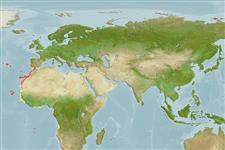Common names from other countries
>
Anguilliformes (Eels and morays) >
Muraenidae (Moray eels) > Muraeninae
Etymology: Enchelycore: Greek, enchelys, = eel + Greek, kore = pupil (Ref. 45335).
More on author: Lowe.
Environment: milieu / climate zone / depth range / distribution range
Écologie
marin démersal; profondeur 3 - 60 m (Ref. 58047). Subtropical; 40°N - 17°S, 32°W - 35°E
Eastern Atlantic: Azores, Madeira, Canary, Cape Verde, Ascension and St. Helena Islands including record from the Mediterranean coast of Israel (Ref. 3256), Greece (Ref. 43448) and Cyprus (Ref. 95695).
Taille / Poids / Âge
Maturity: Lm ? range ? - ? cm
Max length : 120 cm TL mâle / non sexé; (Ref. 5288)
Occasional among rocks and rubble to depths of at least 10 m. They stay concealed among rocks, waiting for prey to come along. Are active predators which feed on crustaceans and fish (Ref. 5377). Possibly consumed in subsistence fisheries (Ref. 3254).
Life cycle and mating behavior
Maturité | Reproduction | Frai | Œufs | Fécondité | Larves
Smith, D.G. and E.B. Böhlke, 1990. Muraenidae. p. 136-148. In J.C. Quero, J.C. Hureau, C. Karrer, A. Post and L. Saldanha (eds.) Check-list of the fishes of the eastern tropical Atlantic (CLOFETA). JNICT, Lisbon; SEI, Paris; and UNESCO, Paris. Vol. 1. (Ref. 4450)
Statut dans la liste rouge de l'IUCN (Ref. 130435)
CITES (Ref. 128078)
Not Evaluated
Menace pour l'homme
Harmless
Utilisations par l'homme
Pêcheries: pêcheries vivrières
Plus d'informations
Noms communsSynonymesMétabolismePrédateursÉcotoxicologieReproductionMaturitéFraiFéconditéŒufsDéveloppement de l'œuf
Taille/ÂgeCroissanceLongueur-poidsLongueur-longueurFréquences de longueursMorphométrieMorphologieLarvesDynamique des populations larvairesRecrutementAbondance
RéférencesAquacultureProfil d'aquacultureSouchesGénétiqueElectrophoresesHéritabilitéPathologiesTraitementMass conversion
CollaborateursImagesStamps, Coins Misc.SonsCiguateraVitesseType de nageSurface branchialeOtolithesCerveauxVision
Outils
Articles particuliers
Télécharger en XML
Sources Internet
Estimates based on models
Preferred temperature (Ref.
115969): 18.4 - 20.1, mean 19.8 (based on 14 cells).
Phylogenetic diversity index (Ref.
82804): PD
50 = 0.5002 [Uniqueness, from 0.5 = low to 2.0 = high].
Bayesian length-weight: a=0.00050 (0.00025 - 0.00101), b=3.26 (3.10 - 3.42), in cm Total Length, based on LWR estimates for this (Sub)family-body shape (Ref.
93245).
Niveau trophique (Ref.
69278): 4.0 ±0.67 se; based on food items.
Résilience (Ref.
120179): Très faible, temps minimum de doublement de population supérieur à 14 ans (Preliminary K or Fecundity.).
Fishing Vulnerability (Ref.
59153): High to very high vulnerability (72 of 100).
